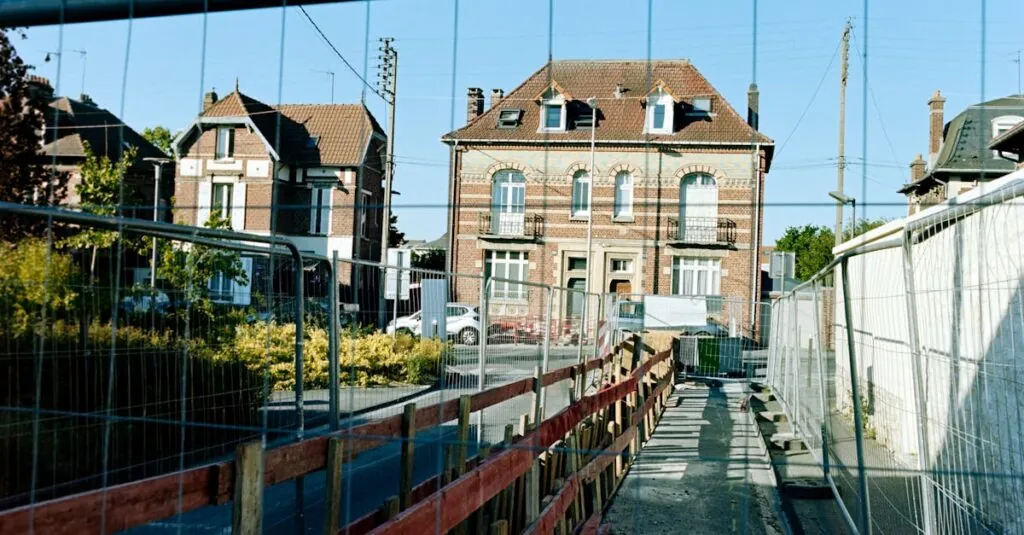In a world where trends can shift faster than a contractor can misplace a hammer, staying updated on residential construction news is crucial. Whether it’s the latest eco-friendly materials or innovative design ideas, the construction landscape is evolving—and it’s not just about building houses anymore. It’s about creating homes that reflect lifestyles and values.
Table of Contents
ToggleRecent Trends In Residential Construction News
Staying current on trends in residential construction remains crucial. The latest shifts emphasize building homes that reflect personal values and lifestyles.
Sustainable Building Practices
Eco-friendly materials gained significant traction in recent months. Builders increasingly prioritize sustainability by using recycled and locally sourced materials. Practices like energy-efficient construction reduce long-term operating costs for homeowners. Solar panels and green roofs now frequently appear in new projects. Certifications such as LEED (Leadership in Energy and Environmental Design) are more common in residential buildings, assuring buyers of environmental responsibility. Homebuyers express rising interest in homes with sustainable features, making them essential in new developments.
Innovations In Home Design
Creative designs shape modern residential architecture. Open floor plans continue to dominate preferences, creating airy and functional living spaces. Smart home technology now integrates seamlessly into new builds, enhancing convenience and security. Builders use modular construction techniques for efficiency and faster completion times. Additionally, biophilic design principles, which incorporate natural elements, enrich indoor environments. Customization trends reflect individual tastes, as homeowners seek unique features tailored to their lifestyles. As such, design innovations play a central role in attracting prospective buyers.
Market Analysis Of Residential Construction
The residential construction market remains dynamic, influenced by various factors impacting both demand and supply.
Current Demand And Supply Dynamics
In recent months, demand for residential construction has surged due to increased homebuyer interest. With low mortgage rates, many buyers are making purchases. High consumer interest has led to a shortage in housing inventory. Builders struggle to keep pace with this demand, affecting project timelines and costs. An increase in remote work opportunities also boosts the desire for larger homes and upgraded amenities. Consequently, the market sees heightened competition among buyers, driving up prices for new construction projects. As a result, builders focus on addressing these supply chain challenges while adapting to market expectations.
Influential Economic Factors
Several economic factors greatly influence the residential construction landscape. Inflation rates significantly impact material costs, creating fluctuations in construction budgets. Changes in unemployment rates affect consumer confidence and buyer spending power. Additionally, interest rate adjustments by the Federal Reserve directly influence mortgage rates and accessibility. Local economic conditions play a role as well, with areas experiencing job growth seeing increased construction activity. Government incentives promoting energy-efficient construction drive demand for eco-friendly building practices. Overall, these factors shape the residential construction market’s direction while presenting both challenges and opportunities for builders.
Regulatory Updates Impacting Residential Construction
Regulatory updates play a crucial role in shaping the residential construction landscape. Recent developments reflect ongoing changes that influence builders and homebuyers alike.
New Housing Policies
New housing policies address the growing need for affordable homes. Government initiatives include incentives for sustainable construction and support for energy-efficient designs. These measures aim to increase housing supply while promoting environmentally friendly practices. Policymakers emphasize the urgency of expanding available options for homebuyers, particularly in urban areas with high demand. Adjustments to financing programs further ensure that low-income families gain better access to homeownership opportunities.
Zoning Laws And Their Effects
Zoning laws significantly affect residential construction by determining land use. Restrictions can limit the types and densities of housing allowed in specific areas. Local governments continuously update regulations to accommodate changing community needs. Adjustments to these laws may enable more multifamily units, which address the inventory shortage seen in many markets. Builders benefit from clearer guidelines and potential opportunities to develop in previously restricted zones. Enhanced collaboration between builders and local planning authorities often leads to more comprehensive urban development strategies.
Technological Advancements In Construction
Technological advancements reshape residential construction, enhancing efficiency and promoting sustainability within the industry.
Smart Home Integration
Smart home integration transforms modern living spaces. Devices like smart thermostats, security systems, and lighting controls increase energy efficiency and enhance convenience. Builders incorporate these features to meet growing consumer demand for technology-driven homes. The market for smart home devices is projected to reach $174 billion by 2025, reflecting rising homeowner interest. Each integration boosts property value, attracting prospective buyers. As technology evolves, homes equipped with smart features gain popularity among environmentally conscious consumers.
Construction Management Software
Construction management software streamlines the residential building process. These solutions provide tools for project scheduling, budgeting, and communication, significantly improving management efficiency. Builders utilize software to enhance collaboration among teams and reduce delays. Industry data shows that adopting such technologies can decrease project costs by up to 30%. This evolution leads to a lower risk of errors and improved transparency throughout the project lifecycle. Remote access capabilities facilitate real-time updates and resource tracking, allowing teams to adapt quickly to changing conditions.
Staying updated on residential construction news is essential for anyone involved in the industry. The shift toward sustainable practices and innovative designs reflects a growing awareness of environmental impact and individual preferences. As demand continues to rise builders must navigate challenges while embracing new technologies that enhance efficiency and sustainability.
Regulatory changes and economic factors will further influence the market dynamics. Collaboration between builders and local authorities can lead to more effective urban development strategies. With these trends shaping the future of residential construction the industry is poised for significant transformation.





